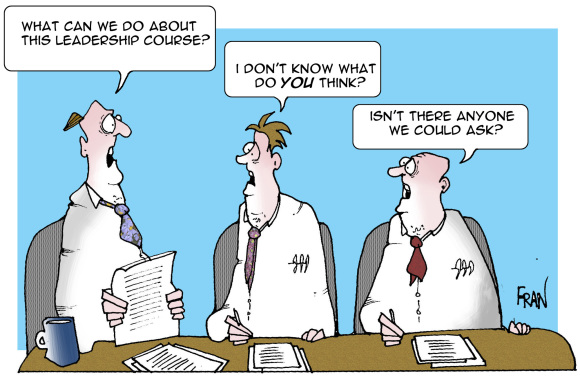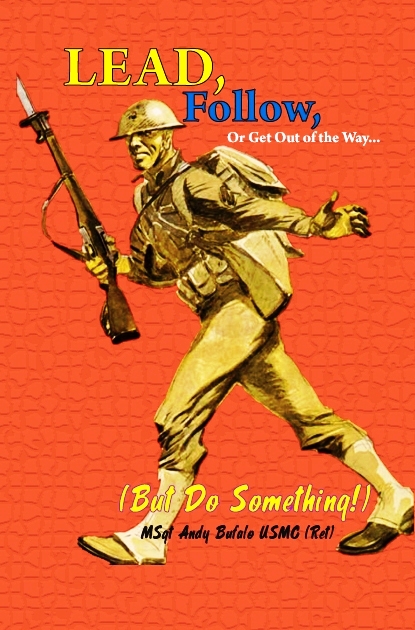Effective leadership is essential to a functioning society. If we did not have effective leaders there would be anarchy. Anarchy can be characterized as a chaotic situation in which the people are not controlled by rules or laws (imagine the zombie apocalypse). On the other end of the spectrum there is absolute totalitarianism. Totalitarianism forces all aspects of your life under the authority of the state, usually with one leader (and his subordinates) calling all the shots (imagine Nazi Germany). Neither of these extreme situations could be defined without the mention of leadership. In the former, there are no leaders. In the latter, there is an all-powerful leader who gives you no say in your life. However, we all know there has to be a better alternative that resides somewhere in between the two extremes. A place where there are “good” leaders, but what does it mean to be a leader? The Merriam-Webster dictionary defines leadership as:
Totalitarianism forces all aspects of your life under the authority of the state, usually with one leader (and his subordinates) calling all the shots (imagine Nazi Germany). Neither of these extreme situations could be defined without the mention of leadership. In the former, there are no leaders. In the latter, there is an all-powerful leader who gives you no say in your life. However, we all know there has to be a better alternative that resides somewhere in between the two extremes. A place where there are “good” leaders, but what does it mean to be a leader? The Merriam-Webster dictionary defines leadership as:
“the power or ability to lead other people” and the “capacity to lead”
This definition generically defines a leader, but what is the definition of a “good” leader? Is the “capacity” to lead enough to make a good leader? Adolf Hitler was a leader, and it is doubtful many could characterize him as “good.”
Social, cognitive, and positive psychologists have studied effective leadership extensively, and found that a characteristic of “good” leaders is that they are “authentic” (think back to Rogers.) Research has found that authentic leadership is positively correlated with a more positive work environment, including increased self-esteem, better sense of well-being, increased friendliness, and better work performance (Grandey, Fiske, Mattila, Jansen, & Sideman, 2005; Kernis, 2003). Avolio, Walumbwa, & Weber (2009) also found authentic leaders to be better leaders. Authentic leadership was defined,
“[a] process that draws from both positive psychological capacities and a highly developed organizational context, which results in both greater self-awareness and self-regulated positive behaviors on the part of leaders and associates, fostering positive self-development” (Luthans & Avolio, 2003)
People naturally tend to desire authentic leadership. Leadership is relevant in all aspects of society (i.e. business, military, clubs, etc.); and good leaders are required to make those sectors function properly. Experts in the business community recognize that,
“[w]hen good leadership is in place in a company, it can be felt throughout the entire organization…[t]he result of good leadership is high morale, good employee retention, and sustainable long-term success” (Anderson, 2013).
Likewise, those same business experts realize,
“[b]ad leadership can also be felt throughout the entire organization – only not in a good way. Corporate culture becomes a meaningless term where leaders claim it exists while employees shake their heads in frustration” (Anderson, 2013).
Good leadership is vitally important in the military too. If military leaders make mistakes, they don’t just lose money, they can lose lives. The U.S. military has also recognized that bad leadership cannot be tolerated, and has coined the term “toxic leadership” to describe the effects of bad leaders.
“Toxic leadership is a combination of self-centered attitudes, motivations, and behaviors that have adverse effects on subordinates, the organization, and mission performance. This leader lacks concern for others and the climate of the organization, which leads to short- and long-term negative effects. The toxic leader operates with an inflated sense of self-worth and from acute self-interest. Toxic leaders consistently use dysfunctional behaviors to deceive, intimidate, coerce, or unfairly punish others to get what they want for themselves. The negative leader completes short-term requirements by operating at the bottom of the continuum of commitment, where followers respond to the positional power of their leader to fulfill requests. This may achieve results in the short term, but ignores the other leader competency categories of leads and develops. Prolonged use of negative leadership to influence followers undermines the followers’ will, initiative, and potential and destroys unit morale” (ADP 6-22)
I believe the reason toxic leadership is such a problem in the Army has to do with how soldiers are indoctrinated. I also believe the U.S. Marine Corps does a much better job at training leadership. In order to weed out toxic leaders in the U.S. Marine Corps, the USMC starts by educating their young Marine enlisted and officers on what good leadership looks like (an applied social psychology intervention should include education, right?) This is a good step in changing and molding behavior. I joined the U.S. Marine Corps when I was 18 years old, and some of the first leadership lessons I had to memorize came in the form of the Marine Corps Leadership Principles:
- Know yourself and seek self-improvement.
- Be technically and tactically proficient.
- Develop a sense of responsibility among your subordinates.
- Make sound and timely decisions.
- Set the example.
- Know your Marines and look out for their welfare.
- Keep your Marines informed.
- Seek responsibility and take responsibility for your actions.
- Ensure assigned tasks are understood, supervised, and accomplished.
- Train your Marines as a team.
- Employ your command in accordance with its capabilities.
In order to operationalize the principles, we told that we must adhere to the 14 Marine Corps Leadership Traits:
- Dependability – The certainty of proper performance of duty.
- Bearing – Creating a favorable impression in carriage, appearance and personal conduct at all times.
- Courage – The mental quality that recognizes fear of danger or criticism, but enables a man to proceed in the face of it with calmness and firmness.
- Decisiveness – Ability to make decisions promptly and to announce them in clear, forceful manner.
- Endurance – The mental and physical stamina measured by the ability to withstand pain, fatigue, stress and hardship.
- Enthusiasm – The display of sincere interest and exuberance in the performance of duty.
- Initiative – Taking action in the absence of orders.
- Integrity – Uprightness of character and soundness of moral principles; includes the qualities of truthfulness and honesty.
- Judgment – The ability to weigh facts and possible solutions on which to base sound decisions.
- Justice – Giving reward and punishment according to merits of the case in question. The ability to administer a system of rewards and punishments impartially and consistently.
- Knowledge – Understanding of a science or an art. The range of one’s information, including professional knowledge and an understanding of your Marines.
- Tact – The ability to deal with others without creating offense.
- Unselfishness – Avoidance of providing for one’s own comfort and personal advancement at the expense of others.
- Loyalty – The quality of faithfulness to country, the Corps, the unit, to one’s seniors, subordinates and peers.
This “indoctrination” might be the reason the Marine Corps leadership is more effective than its sister services. We learned these principles and traits by heart, and had to recite them in order to be promoted to leadership positions. We learned the traits using the mnemonic “JJ-DID-TIEBUCKLE.” Psychologists have found that using the techniques of chunking, priming, and active-learning help to solidify these kinds of concepts (Bodie, Powers, & Fitch-Houser, 2006). The Marine Corps education process uses those techniques.
USMC-taught principles and traits also inculcate the “four factors that cover the components of authentic leadership” as described by Avolio et al. (2009): balanced processing, internalized moral perspective, relational transparency, and self-awareness. The way the USMC indoctrinates these leadership lessons also clearly demonstrates to me the value of applied social psychology interventions to change, and hopefully improve leadership behavior. The USMC indoctrination process also underscores the concept that although some people believe real leaders are born to be leaders – there are some positive leadership traits people are born with – much of what a leader needs to be a good leader can be learned.
“Preliminary evidence using a behavioral genetics approach has shown that approximately 30 percent of the variation in leadership style and emergence was accounted for by heritability; the remaining variation was attributed to differences in environmental factors such as individuals having different role models and early opportunities for leadership development” (Arvey, Zhang, Avolio, & Krueger, 2007).
Lastly, although it is important to learn to be a good leader, it is just as important to learn to be a good follower. The success of any good team relies on synergy. In other words, a good leader can’t be successful without the efforts of his/her team. Researchers have “proposed a social constructionist theory to describe the relationship between leadership and followership.
 They argued that leadership is significantly affected by the way followers construct their understanding of the leader in terms of their interpretation of his or her personality, behaviors, and effectiveness” (Avolio, Walumbwa, & Weber, 2009).
They argued that leadership is significantly affected by the way followers construct their understanding of the leader in terms of their interpretation of his or her personality, behaviors, and effectiveness” (Avolio, Walumbwa, & Weber, 2009).
Leadership is incredibly important, and we need to have good leaders to make society function. People can learn to become good and authentic leaders over time with the right instruction. Well designed and implemented applied social psychology interventions (like the USMC model) can make this possible.
======================================
References:
Anderson, A. (2013). Good Leaders Are Invaluable To A Company. Bad Leaders Will Destroy It. Retrieved from http://www.forbes.com/sites/amyanderson/2013/01/14/good-leaders-are-invaluable-to-a-company-bad-leaders-will-destroy-it/
Arvey, R., Zhang, Z., Avolio, B., & Krueger, R. (2007). Developmental and genetic determinants of leadership role occupancy among women. Journal of Applied Psychology. 92: 693–706
Avolio, B., Walumbwa, F., & Weber, T. (2009). Leadership: Current Theories, Research, and Future Directions. Annual Review of Psychology 60, pp. 421-449
Bodie, G., Powers, W. & Fitch-Hauser, M. (2006). Chunking, Priming and Active Learning: Toward an innovative and blended approach to teaching communication-related skills. Interactive Learning Environments. 14,2: 119-135.
Department of the Army (2012). Definition of Toxic Leadership. Army Leadership – Army Doctrinal Publication (ADP) 6-22. Retrieved from http://armypubs.army.mil/doctrine/DR_pubs/dr_a/pdf/adp6_22_new.pdf
Grandey, A. A., Fiske, G. M., Mattila, A. S., Jansen, K .J., & Sideman, L. A. (2005). Is “service with a smile” enough? Authenticity of positive displays during service encounters. Organizational Behavior and Human Decision Processes, 96: 38-55.
Kernis, M. (2003). Toward a conceptualization of optimal self-esteem. Psychological Inquiry. 14: 1-26.
Leadership. (n.d.). Retrieved November 25, 2014 from, http://www.merriam-webster.com/dictionary/leadership
Luthans, F., & Avolio, B. (2003). Authentic leadership development. In K. S. Cameron, J. E. Dutton, & R. E. Quinn (Eds.), Positive organizational scholarship: 241-258. San Francisco: Berrett-Koehler.
Walumbwa, F., Avolio, B., Gardner, W., Wernsing, T., & Peterson, S. (2008). Authentic leadership: development and validation of a theory-based measure. Journal of Management. 34, 89-126


